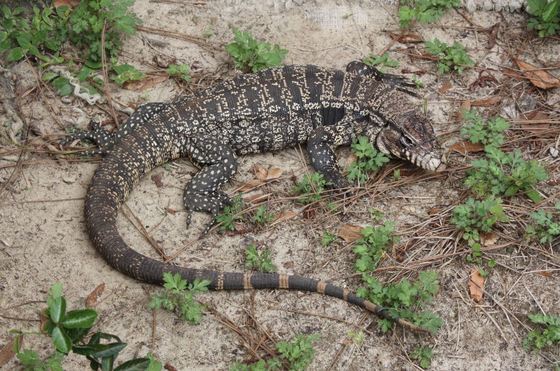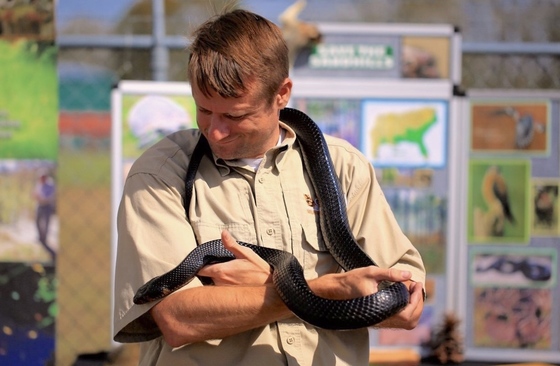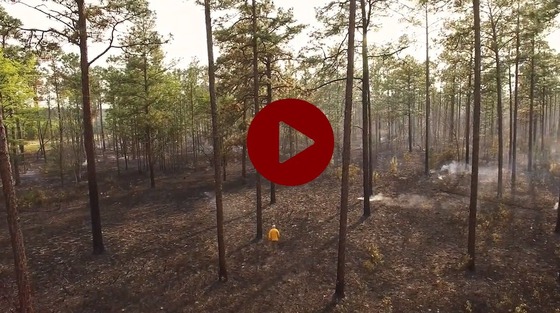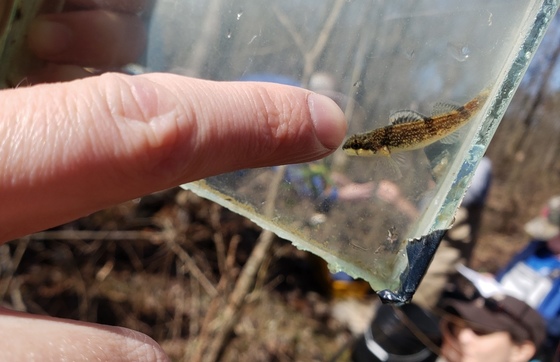IN THIS ISSUE
- A unique tree few know about
- On the lookout for invasive lizards
- Claxton set for wildlife and rattler fest
- Fire that restores rare species, habitats
- Sampling for threatened trispot darters
 When in bloom, fringe trees look like they're covered in white lace. (Terry W. Johnson)
By TERRY W. JOHNSON
One of Georgia's least known flowering trees goes by a number of colorful names, including grancy graybeard, granddaddy's beard, old-man's beard, snow flower tree and flowering ash.
To botanists, however, it’s fringe tree (Chionanthus virginicus).
Yet even more interesting than the list of common names is that although fringe tree is one of our most beautiful native trees, few people have the slightest idea what it looks like. That’s easy to understand in summer, fall and winter, when fringe tree lacks any easily distinguished features.
But in late spring, this tree’s appearance and the perfume from its unusual flowers make it stand out …
Read the rest of Terry’s column on grancy graybeard.
Terry W. Johnson is a retired DNR program manager and executive director of TERN, the DNR Wildlife Conservation Section’s friends group. Read his columns, Backyard Wildlife Connection blog and book “A Journey of Discovery: Monroe County outdoors.” (Permission is required to reprint this column.)
Top
 An Argentine black and white tegu in Florida (Stan Kirkland/FWC)
Argentine black and white tegus are big South American lizards that are popular in the pet trade but trouble when released in the wild. Tegus have been causing problems in Florida for years.
Now it’s possible these reptiles that can grow up to 4 feet long have a toehold in south Georgia.
Talk of large, odd-looking lizards has been circulating in eastern Toombs and western Tattnall counties. They’ve been spotted crossing dirt roads. They've turned up on game cams. One was even trapped in a farmer’s shop.
Underscoring the stories, since last summer DNR has documented at least four adult Argentine black and white tegus and 20 sightings in the stretch of forest, farmland and sandy-bottomed streams from Lyons to Reidsville. Senior wildlife biologist John Jensen and others at DNR investigating the issue are concerned the area has a breeding population, although recruitment – young tegus – has not been confirmed.
“We think there’s something going on,” Jensen said. “But we need to know more.”
DNR is encouraging residents to report tegu sightings. The agency will emphasize that message at the Claxton Rattlesnake and Wildlife Festival this weekend, only a 20-minute drive from the Toombs/Tattnall County line.
Why the worry? Argentine black and white tegus are an invasive species that grows large, reproduces fast and eats lots of things, from fruit to eggs, birds and small mammals. Tegus would pose a threat to native wildlife, including gopher tortoises, a candidate for Endangered Species Act listing. Tegus have been documented using gopher tortoise burrows and eating tortoise eggs and the young.
The eggs of ground-nesting birds such as northern bobwhites and wild turkeys could be susceptible. Tegus also will eat vegetables, pet food and chicken eggs.
If tegus are reproducing in the wild, catching them early is crucial. Once established, as with Florida’s two known populations, the only effective response is trying to stem their numbers and spread. Meanwhile, a study published last year rated much of the Southeast as potentially suitable for Argentine black and white tegus.
With the winter dormancy period ending and tegus’ reproductive season starting, DNR has a simple request regarding the non-native reptiles: “If you’ve seen something,” Jensen said, “let us know.”
Top
 Tegus in Toombs: left, photographed by a resident; right, near a live trap set by DNR's Jim Gillis
HOW TO REPORT
Take a photo, note the location and report the sighting -- including of dead tegus -- at www.gainvasives.org/tegus. Questions? Contact (478) 994-1438 or john.jensen@dnr.ga.gov.
TEGUS ARE …
- Native to South America. The Argentine black and white tegu (Salvator merianae) is native to Brazil, Paraguay, Uruguay and Argentina.
- Terrestrial lizards, rarely found more than a few feet off the ground, although they are also strong swimmers.
- Popular in the pet trade. Yet in the wild, they can reproduce quickly: Reproductive-age females lay about 35 eggs year.
- Not considered aggressive but will defend themselves if threatened or harassed. They can react fast and have sharp teeth and claws, strong jaws, and a strong tail.
- Legal in Georgia to own as pets. However, it is illegal to release any animal into the wild.
- Not protected by Georgia wildlife laws or regulations, although local ordinances may apply.
DID YOU KNOW
Georgia's State Wildlife Action Plan rates non-native invasive animals and plants a significant threat to native wildlife. The plan is a comprehensive strategy for conserving wildlife and natural habitats statewide.
Top
 DNR's Matt Moore with an eastern indigo snake at last year's festival (Paul Evans)
Snakes and wildlife exhibits, cars and archery, crafts, food and fairground rides: The 52nd annual Claxton Rattlesnake and Wildlife Festival will feature a rich mix of attractions this Saturday and Sunday.
Highlights vary from a birds of prey show by Georgia Southern University’s Center for Wildlife Education to a 3D archery tournament and a Rattlesnake Run. In between, thousands of visitors will take in more than 100 vendors, including DNR booths featuring live wildlife and hunting and fishing simulators.
The former rattlesnake roundup saw support and the number of snakes surge after it stopped buying and selling wild-caught rattlers in 2012, a change backed by conservation organizations. Now centered on wildlife education, the festival draws thousands. Hours are 8 a.m.-6 p.m. Saturday and 10 a.m.-5 p.m. Sunday.
IN FITZGERALD, ITS WILD CHICKENS
Another rattler roundup turned community festival takes place next week in Fitzgerald. The city's annual Wild Chicken Festival sports music, a street dance, arts and crafts, and even a knife juggling show March 14-16.
The namesake wild chickens, descendants of Burmese red junglefowl released in the 1960s, are recognized in a yearly chicken crowing contest.
Top
 By SHAN CAMMACK
The smell of wood burning. The persistent pops and cracks of vegetation being consumed: crisp oak leaves, slender pine needles, waxy palmetto fronds.
Wisps of smoke curling through the canopy of trees to join sunset streaks of rose and purple on the horizon. Pink flagging draped over gopher tortoise burrows as if in a strange interpretive dance to warn loggers of their presence. A bird darting in to snag an insect on the blackened earth. A dibble blister on your palm. A neck sore from carrying a planting bag of longleaf plugs.
Wildlife conservation has many faces. The most important in Georgia is fire.
Fire is a natural process that has shaped habitats and ecosystems across the state for thousands of years. Many of Georgia’s wildlife species thrive on and even require fire to survive. That’s why DNR uses fire to help manage its lands. But we pick the day, the weather, the fuel conditions. It’s called prescribed burning. And it's a safe way to mimic a natural process, improve ecosystem health and reduce the risk of wildfire.
Georgia celebrated Prescribed Fire Awareness Week in February. Now it’s up to all of us to keep spreading the word about the importance of prescribed burning. Tell friends who aren’t familiar with it.
At DNR, we'll continue burning pyric habitats, prepping land for planting longleaf pines, reducing hazardous fuel loads that can feed wildfires and restoring rare species.
Shan Cammack is fire management officer for the Wildlife Conservation Section.
Top
Turn tax pains into wildlife gains: Contribute to the Georgia Wildlife Conservation Fund when filing your state income tax return. Helping wildlife for nearly 30 years, the tax checkoff made up percent of last year's revenue for the fund, dedicated by law to conserving Georgia wildlife not hunted or fished for, rare plants, natural habitats and projects to raise awareness of this work. How donations are used.
What to do if you encounter a bear, whether in the wild or your backyard? Learn about being Bearwise at www.BearWise.org. (Backyard basics on video.)
Nearly 120 bats were found recently roosting in an Interstate 20 culvert west of Atlanta, the most bats DNR has seen using a culvert. Tipped off by the University of West Georgia, Wildlife Conservation Section staff documented one federally endangered gray bat at the site, with the rest being tri-coloreds, a state species of concern (take a peek into the culvert). Details on DNR bat surveys.
Camp TALON is looking for a few more teens interested in a deep dive into coastal birding and ecology this summer. The DNR camp is June 1-6, but those who register before April 5 receive a discount.
 Plant restoration last month at Ohoopee Dunes Wildlife Management Area near Swainsboro included transplanting sandhill rosemary seedlings (above left) to establish a population along the McLeod Bridge Interpretive Trail. Botanist Dr. J. Mincy Moffett Jr. also led a workday at a parrot pitcherplant site that found five more small patches of plants and thinned shrubs and trees around all.
Want to join this year’s Youth Birding Competition? The deadline to register for the April 26-27 birdathon is March 31! Ages K-12th grade can take part, and no birding experience is required.
The osprey nest livestreamed at The Landings near Savannah has an egg. Follow the fish-eating raptors on the Cornell Lab of Ornithology, Facebook and Twitter.
Candler Park is an Atlanta hotspot for birds, with 95 species reported on eBird. But Atlanta Audubon aims to make the park even more birdy by awarding the Candler Park Conservancy a grant to remove invasive and exotic plants such as privet and porcelain berry and plant bird-friendly native species.
Top
COMING UP
March 9-10 -- Claxton Rattlesnake and Wildlife Festival, Hagan
March 14-16 -- Fitzgerald Wild Chicken Festival, Fitzgerald
March 16 – Banff Mountain Film Festival, Ferst Center for the Arts, Georgia Tech
March 22-24 – Confluence (Georgia Adopt-A-Stream volunteer water-quality monitoring conference), Unicoi State Park and Lodge, Helen
April 13-May 19 – 2019 Atlanta Bird Fest, Atlanta Audubon Society
April 24-25 – Identification, mapping, control of invasive pests, UGA, Tifton
May 3 -- Wild for Georgia (The Nature Conservancy), 7-11 p.m., Piedmont Park, Atlanta
May 18 – Keeping Georgia Wild Family Festival, Charlie Elliott Wildlife Center, Mansfield
WHAT YOU MISSED …
In the previous Georgia Wild:
- Year of wildlife work in review
- New whale calves, new video
- Bald eagles vs. sandhill cranes
- Pecans for the birds? You bet
Top
"Three great white sharks tagged off Hilton Head," Savannah Morning News
"DNR: Viral gator pic is no hoax," Cordele Dispatch
"Aquatic diversity featured on Georgia biodiversity portal," Georgia Adopt-a-Stream
"Study links declines in suburban birds to presence of nonnative plants," Smithsonian National Zoo and Conservation Biology Institute
"Nine-plus Georgia state parks with waterfalls to visit," 365 Atlanta Traveler
"Student artists invited to Georgia Junior Duck Stamp competition," U.S. Fish and Wildlife Service
"Butterflies aren’t expendable; our brittle reality depends on them, too," The Washington Post
 VIDEO
"Partners for Conservation: Reese Thompson and longleaf pine," Partners for Conservation
"Great horned owls visit Savannah (Landings) nest," Cornell Lab of Ornithology
"Big brother: the lost tortoise episode," (game cams monitor activity at a tortoise burrow in southwest Georgia), Archbold Biological Station
Top
 Trispot darter (Ani Popp/DNR)
No longer than 2 inches and found only in the Coosa River Basin in Georgia, Alabama and Tennessee, trispot darters were listed as threatened under the Endangered Species Act in January. DNR’s Wildlife Conservation Section is partnering with the Geological Survey of Alabama, the University of West Alabama and the Cawaco Resource, Conservation and Development Council to conduct an environmental DNA study of trispots. Dubbed eDNA, this aquatic tool allows scientists to check for a species’ presence by analyzing water samples for its DNA. The process isn’t definitive. A species may be present even if its DNA isn’t detected, and positive samples don’t reveal the number of animals or where they are. But eDNA does help biologists streamline sampling by focusing on areas where a target species’ DNA is found. From January through March this year and next, partners are sampling waterways in the trispot darter’s known range, as well as areas the fish hasn’t been found but could occur. A better understanding of the trispot's range can concentrate research and conservation efforts for recovering the species.
 DNR's Peter Dimmick collects a water sample to check for darter DNA. (Ani Popp/DNR)
TRISPOT INSIGHTS
- During breeding season, males are bright orange with large blue spots.
- Females and non-breeding males are light brown with three dark saddles down their backs.
- Trispots normally live in larger streams and rivers, but in winter they make like miniature salmon, swimming upstream into smaller tributaries to spawn.
- The fish spawn in ditches and intermittent streams filled by winter rains. There, the young hatch and grow before swimming downstream to join the adults in the river.
— Ani Popp, DNR Coosa River aquatic biologist
CREDITS
Masthead: Argentine black and white tegu (Stan Kirkland/FWC)
Sandhill rosemary photos: DNR's Dr. Mincy J. Moffett Jr., left, and Morgan Bettcher plant seedlings at Ohoopee Dunes (DNR); far right, an established rosemary at the WMA (Alan Cressler)
Top
|